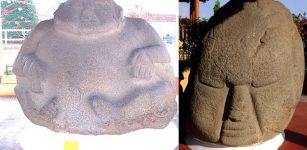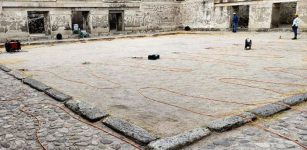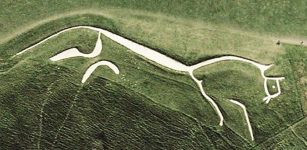Utnapishtim And The Babylonian Flood Story
Ellen Lloyd - AncientPages.com - The ancient story of the great Flood has been re-told worldwide. We find accounts of the event among many ancient cultures all across the world. They all have myths and legends describing a time in the distant past when a horrifying Deluge wiped almost all life on Earth.
The story of Noah’s Ark is not just a Biblical story. Noah was known under a different name in India, among ancient Egyptians and Native Americans, to mention a few cultures.
The life of Utnapishtim and the Babylonian Flood Story are described in the Epic of Gilgamesh. Just like Noah, Utnapishtim is the survivor of the Deluge. Gilgamesh is the semi-mythic King of Uruk best known from The Epic of Gilgamesh (written c. 2150-1400 BCE) the great Sumerian/Babylonian poetic work.
Memories of an antediluvian (pre-flood) period were preserved throughout Mesopotamia: The Sumerian King List includes antediluvian kings, and reliefs of antediluvian sages known as apkallu, winged and bird-headed creatures lined the walls of Assyrian palaces and remain one of the most iconic forms of Mesopotamian art to this day.
The Chaldean Flood Tablets from the city of Ur in what is now Southern Iraq contain a story that describes how the Babylonian god Enlil had been bothered by the incessant noise generated by humans. To punish people he sends a Deluge to wipe out life on the planet.
The Sumerian god Enki, later known as Ea in Akkadian and Babylonian mythology went against the decision of the rest of the gods and ordered Utnapishtim to abandon his worldly possessions and create a huge ship to be called The Preserver of Life.
The ship was made of solid timber so that the rays of Shamash (the Sun) would not shine in, and of equal dimensions in length and width. God Enki assisted with the design and construction of The Preserver of Life. The building of the ship took five days. The ship’s interior had seven floors, each floor divided into 9 sections, finishing the ark fully on the seventh day.
Knowing that the oncoming flood would wipe out all life on Earth, Utnapishtim was told to quickly take his wife, relatives, some of the villagers, animals along with various grains and seeds and board the ship. The entrance to the ship was sealed once everyone had boarded it.
Utnapishtim spent 12 days on The Preserver of Life. When he finally felt it was safe to open the hatch, he saw the slopes of Mount Nisir, supposedly the mountain known today as Pir Omar near the city Sulaymaniyah in Iraqi Kurdistan. Researchers have speculated the name may mean "Mount of Salvation".
He waited seven days before he sent a dove out to see if the water had receded, but the dove could not find anything but water and returned. Utnapishtim repeated the procedure. Next time he sent out a swallow, and just as before, it returned, having found nothing. Finally, Utnapishtim sent out a raven, and the raven saw that the waters had receded, so it circled around but did not return. Utnapishtim then set all the animals free and made a sacrifice to the gods.
The gods were happy he had obeyed their wish and preserved the seed of man. In return for his trust and loyalty, the gods gave him and his wife the gift of immortality and a place among the heavenly gods.
The story of the quest for immortality is explored in the Epic of Gilgamesh.
Gilgamesh, who is devasted by the death of his brother Enkidu sets out on a series of journeys to search for his ancestor Utnapishtim who lives at the mouth of the rivers and has been given eternal life. Gilgamesh fears his own death and searches for a way to preserve his life forever.
Utnapishtim tells Gilgamesh to abandon his search for immortality but tells him that there is a place where the Flower of Immortality is located and that it can restore his youth and the youth of others. Gilgamesh gets the flower and leaves for home with the boatman, but along the way, a serpent in the pool steals the flower and it is lost. An interesting symbol of evil similar to the bible is the snake or the serpent.
Left: The Babylonian Flood Tablet translated by George Smith in the mid/late 19th century. The British Museum.
Right: The so-called Ark Tablet, recently translated by Irving Finkel, is an Old Babylonian (1900-1700 B.C.E.) account of the flood in which the god Enki instructs Atrahasis—the Babylonian Noah—on how to build an ark.
Gilgamesh returned home to the city of Uruk, having abandoned hope of either immortality or renewed youth.
The tale of Utnapishtim and the Earth before the Great Flood would have all been forgotten had it not been for his chance of acquaintance with the hero Gilgamesh.
The Epic of Gilgamesh has been of interest to Christians ever since its discovery in the mid-nineteenth century in the ruins of the great library at Nineveh, with its account of a universal flood with significant parallels to the Flood of Noah's day.
While there are great similarities between the Biblical and Babylonian flood stories, there are also certain fundamental differences.
Whether the Deluge story is based on something that really took place or is just a myth remains unknown, but there are scientists who are convinced the Great Flood and Noah’s Ark were real events.
Written by Ellen Lloyd – AncientPages.com
Copyright © AncientPages.com & Ellen Lloyd All rights reserved. This material may not be published, broadcast, rewritten or redistributed in whole or part without the express written permission of AncientPages.com and Ellen Lloyd
More From Ancient Pages
-
 Forseti: Norse God Of Justice And Lawmaker Who Lived In A Shining House
Featured Stories | May 1, 2016
Forseti: Norse God Of Justice And Lawmaker Who Lived In A Shining House
Featured Stories | May 1, 2016 -
 Atomic Theory Was Invented 2,600 Years Ago By Acharya Kanad – A Genius Ahead Of His Time
Featured Stories | May 15, 2014
Atomic Theory Was Invented 2,600 Years Ago By Acharya Kanad – A Genius Ahead Of His Time
Featured Stories | May 15, 2014 -
 Rare 7,000-Year-Old Clay Figurine Discovered In Battifratta Cave, Lazio
Archaeology | Jul 29, 2023
Rare 7,000-Year-Old Clay Figurine Discovered In Battifratta Cave, Lazio
Archaeology | Jul 29, 2023 -
 Earth’s First Animals Had Particular Taste In Real Estate
Evolution | May 10, 2023
Earth’s First Animals Had Particular Taste In Real Estate
Evolution | May 10, 2023 -
 Humans Spread The Black Death – Not Rats – Scientists Say
Archaeology | Feb 7, 2018
Humans Spread The Black Death – Not Rats – Scientists Say
Archaeology | Feb 7, 2018 -
 Strange Case Of The ‘Impossible’ Glove Remains Unexplained – The Discovery – Part 1
Featured Stories | May 24, 2019
Strange Case Of The ‘Impossible’ Glove Remains Unexplained – The Discovery – Part 1
Featured Stories | May 24, 2019 -
 Enigma Of The Mysterious Ancient Shining Twins – The Cosmos Connection – Part 2
Ancient Mysteries | Jun 8, 2020
Enigma Of The Mysterious Ancient Shining Twins – The Cosmos Connection – Part 2
Ancient Mysteries | Jun 8, 2020 -
 Oxygen Spike Coincided With Ancient Global Extinction
Archaeology | Sep 3, 2021
Oxygen Spike Coincided With Ancient Global Extinction
Archaeology | Sep 3, 2021 -
 In The Neanderthal Site Of Combe-Grenal, France: Hunting Strategies Were Unaffected By Changing Climate
Archaeology | Jan 19, 2023
In The Neanderthal Site Of Combe-Grenal, France: Hunting Strategies Were Unaffected By Changing Climate
Archaeology | Jan 19, 2023 -
 Mysterious Viking Burial Site Of Three Women In Norway Reveals Its Secrets
Vikings | Dec 26, 2024
Mysterious Viking Burial Site Of Three Women In Norway Reveals Its Secrets
Vikings | Dec 26, 2024 -
 Sacred City Of Caral – Site Of The Oldest Known Civilization In The Americas
Civilizations | Aug 28, 2018
Sacred City Of Caral – Site Of The Oldest Known Civilization In The Americas
Civilizations | Aug 28, 2018 -
 Mystery Of Ancient Magnetic Potbelly Statues In Mesoamerica Revealed – But Something Is Still Wrong
Archaeology | Jul 30, 2019
Mystery Of Ancient Magnetic Potbelly Statues In Mesoamerica Revealed – But Something Is Still Wrong
Archaeology | Jul 30, 2019 -
 Rare Gilded Mask Discovered On Mummy Of Ancient Egyptian Priest Serving Sky Goddess Mut
Archaeology | Jul 17, 2018
Rare Gilded Mask Discovered On Mummy Of Ancient Egyptian Priest Serving Sky Goddess Mut
Archaeology | Jul 17, 2018 -
 Once-In-A-Lifetime Find – Ancient Roman and Saxon Cemetery Unearthed In Leeds
Archaeology | Mar 30, 2023
Once-In-A-Lifetime Find – Ancient Roman and Saxon Cemetery Unearthed In Leeds
Archaeology | Mar 30, 2023 -
 Mysterious Clay Tablet Reveals Babylonians Used Trigonometry 1,000 Years Before Pythagoras
Archaeology | Aug 24, 2017
Mysterious Clay Tablet Reveals Babylonians Used Trigonometry 1,000 Years Before Pythagoras
Archaeology | Aug 24, 2017 -
 Rare Iron- And Viking-Age Mortuary Houses Discovered In Norway
Archaeology | Aug 27, 2024
Rare Iron- And Viking-Age Mortuary Houses Discovered In Norway
Archaeology | Aug 27, 2024 -
 Oxford University Is Older Than The Aztec Empire – Historical Records Say
Ancient History Facts | Dec 5, 2017
Oxford University Is Older Than The Aztec Empire – Historical Records Say
Ancient History Facts | Dec 5, 2017 -
 Has The Mysterious Ancient Underground Labyrinth Of Mitla Finally Been Found?
Archaeology | Aug 14, 2023
Has The Mysterious Ancient Underground Labyrinth Of Mitla Finally Been Found?
Archaeology | Aug 14, 2023 -
 Murder Of Archbishop Thomas Becket: One Of Most Famous Crimes Of Middle Ages
Featured Stories | Jan 6, 2017
Murder Of Archbishop Thomas Becket: One Of Most Famous Crimes Of Middle Ages
Featured Stories | Jan 6, 2017 -
 Mystery Of Prehistoric Gigantic Hill Figures Of England
Featured Stories | Sep 20, 2018
Mystery Of Prehistoric Gigantic Hill Figures Of England
Featured Stories | Sep 20, 2018



